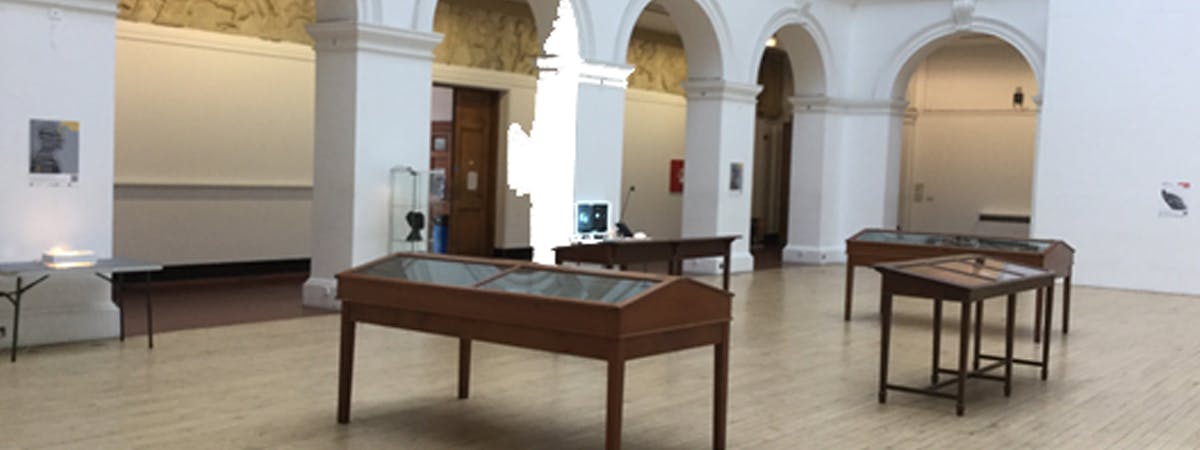The Adorned Afterlife network was established by Bottomley in 2015 while he worked at the University of Edinburgh. Bottomley brought together a network of international researchers from Design, Archaeology, Forensic Anthropology, History and Museology to examine hidden objects of adornment and share discourse and analysis through high-quality speculative multidisciplinary research.

Adorned Afterlife display, Main Sculpture Court ECA 31.03.16
Researchers
- Stephen Bottomley PI, Director of Jewellery and Silversmithing
- Diego Zamora Research Assistant / PhD researcher
- Dr Elena Kranioti, Lecture, Forensic Anthropology, University of Edinburgh
- Dr Margaret Maitland Curator Ancient Mediterranean, National Museums Scotland (NMS)
- Dr Lore Troalen Analytical scientist/Conservation, National Museums Scotland (NMS)
- Dr Elizabeth Moignard Professor of Classical Art and Archaeology, University of Glasgow
- Dr Siobhan McLaughlin, Consultant Radiologist, Royal Infirmary of Edinburgh
- Dr Jack Ogden, Jewellery Historian and Author
- Gay Penfold Associate Professor Jewellery Industry Innovation Centre, School of Jewellery, Birmingham City Uni.
- Dr Ben Russell, Classical Archaeology, University of Edinburgh
- Elizabeth Turrell, Curator/ Vitreous Enamel Artist
- Giovanni Corvaja, Master Italian Goldsmith
Research background
Bottomley continued writing up the project 2017-18 at the School of Jewellery, where some of the other network members already worked with colleagues. The findings of the research were further presented in the paper ‘The Quick and the Dead: the Changing Meaning and Significance of Jewellery Beyond the Grave’ (Bottomley) at the Canadian Craft Biennale (2017) and a juried paper ‘the Adorned Afterlife Research Network’ in the Journal for Jewellery Research (2018).
Research aims
Museums contain many intangible artefacts from our past that relate to the body as adornment. These objects may be represented in paintings and carvings, or literally buried in sarcophaguses or beneath layers of funereal wrappings. The interdisciplinary nature of the network enabled the examination of these items through each other’s specialist expert lens, leading to the insight that although we saw the same item, we used different terms and language to describe its attributed use and meaning. Collectively we speculated on their purpose (why were they made), significance (both then and now) and how they were made (and by whom).
Research methods
The methodology followed practice-based research, comparing craft makers primary knowledge with curators secondary and tertiary sources via filmed interviews and presentations through each other’s lens of enquiry, to “learn by active experience and reflection on that experience” (Gray & Malins, 2004).
The network’s 2016 symposium co-ordinated by the researcher explored existing precedents and new technologies for the non-invasive examining of artefacts and paintings in museums by computerised tomography (CT) and magnetic resonance imaging (MRI) scanning. A focus was the funereal adornments, carefully sited personal objects, placed beneath the wrapped and sealed bandages of Rhind Mummy at the Granton archives, the National Museum of Scotland.
Research outcomes
The methodology followed practice-based research, comparing craft makers primary knowledge with curators secondary and tertiary sources via filmed interviews and presentations through each other’s lens of enquiry, to “learn by active experience and reflection on that experience” (Gray & Malins, 2004).
The network has encouraged high quality speculative multidisciplinary research involving archaeological and anthropological issues and engagement between disciplines that would not otherwise have an opportunity or forum to share discourse and analysis. Network members Dr Jack Ogden and Elizabeth Turrell have both been Visiting Professors at the institute since 2017/18.
Additional links
Find out more about the Adorned Afterlife symposium lectures and films or read the journal paper.